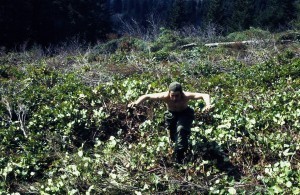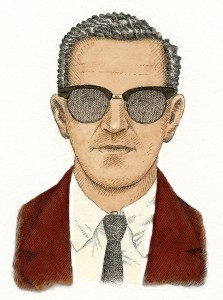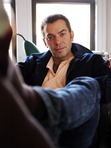Geoffrey Gray's Blog, page 8
August 31, 2011
The Pioneer v.s. The NB6
In recent years, it's been the contention by Bureau agents that the hijacker wasn't all that expert in the use of parachutes. The reason, they've surmised, is evident in the parachute Cooper chose to jump with.
During the hijacking, two very different rear or back pack parachutes were brought on board. One was a Pioneer, used for recreational jumps. It had foam padding and was easy to steer. The other chute was the NB6, or Navy Back 6, a rugged military chute. It had a conical canopy and would be hard to steer.
Cooper chose the NB6. Was this a good or bad choice?
Within the Bureau's headquarters in Seattle, one assessment was the NB6 was a poor if not deadly choice. If the hijacker couldn't steer, how would he know where he was. Plus the rip chord on the NB6 is tough to release. It's likely, feds contended, that Cooper's canopy could have never opened.
In recent weeks, however, I've been approached by numerous lifelong parachutists who've told me that Cooper must have been an expert skydiver or at least very familiar with skydiving because the NB6 was in fact the better if not only choice. At the speed of two hundred miles an hour, which is how fast the hijacked plane was flying, the canopy of a recreational chute like the Pioneer could have ripped apart. The canopy of the NB6 was reinforced. Plus it would be moving slower, and thus easier to land in trees.
I'm itching to know more about the merits of the Pioneer and NB6, and it's one of many mysteries in the case that will be explored at this year's symposium in Portland, scheduled for the morning and afternoon of November 26th, and just before the fortieth anniversary Cooper party at the Ariel Tavern in Ariel, Washington. Stay tuned for more details.
August 22, 2011
Number 25
Fellow D.B. Cooper faithful:
Some news to report. Yesterday, the Times published it's list of bestsellers and SKYJACK made it. The book is now at 25. This is a big deal, and I thank you all for making it happen.
A lot of Cooper news in the works, Symposium updates, some contests, etc. Stay tuned.
August 18, 2011
How Thick These Woods
Could D.B. Cooper have survived the jump?
Maybe.
But could he have escaped from the thorny brambles that cover the floor of the remote forests of southwest Washington?
Here is an example of how thick the woods were back in 1971. While many of the remote areas along the flight path of Northwest 305 have been developed, here is what Bureau agents and soldiers had to march through in the spring of 1972 as they looked for the hijacker.
August 17, 2011
Symposium Picks Up Steam
Over the past week (and especially over drinks after last night's reading in Seattle) there's been considerable interest in holding a Cooper symposium in honor of the fortieth anniversary of the hijacking.
The goal of the symposium is for Cooper sleuths from around the world to come together in a casual yet scholarly setting and share different theories about the case in the hopes of generating new leads.
In the next few days, I will be locating a venue. It will likely be held in Portland, and on the morning of Saturday, November 26th, the same day as the annual Cooper Days party at the Ariel Tavern in Ariel, Washington.
While initially hesitant about hosting the symposium on the same day as the party, I want to give the Cooper faithful enough time to get to Portland after the Thanksgiving holiday. It will be a travel nightmare no matter where you are coming from, but I think it's our best and only shot.
After the symposium, we can make our exodus to the party in Ariel.
In general, I see the symposium broken down into two main categories: The Suspects and The Case. If you are interested in presenting information, the presentation must be well thought out and executed. A good example of a presentation topic might be: "The Pro's and Con's of Using an NB6 Parachute When Jumping From a Commercial Airliner." Or: "Uncle L.D. Cooper: The Facts." Or?
If you have any suggestions, send them in, and stay tuned for more.
Cooper Symposium Picks Up Steam
Over the past week (and especially over drinks after last night's reading in Seattle) there's been considerable interest in holding a Cooper symposium later this year.
In honor of the fortieth anniversary of the hijacking, the goal of the symposium is for Cooper sleuths from around the world to come together in a (semi) scholarly setting and share different theories about the case in the hopes of generating new leads.
In the next few days, I will be locating a venue for the symposium. It will likely be held in Portland, and on the morning of Saturday, November 26th, the same day as the annual Cooper Days party at the Ariel Tavern in Ariel, Washington.
While initially hesitant about hosting the symposium on the same day as the party, I want to give the Cooper faithful enough time to get to Portland after the Thanksgiving holiday. It will be a travel nightmare no matter where you are coming from, but I think it's our best and only shot.
After the symposium, we can make our exodus to the party in Ariel.
In general, I see the symposium broken down into two main categories: The Suspects and The Case. If you are interested in presenting information, the presentation must be well thought out and executed. A good example of a presentation topic might be: "The Pro's and Con's of Using an NB6 Parachute When Jumping From a Commercial Airliner." Or: "Uncle L.D. Cooper: The Facts."
And on.
If you have any suggestions, send them in, and stay tuned for more.
August 16, 2011
The missing ingredient: gravity
Big deal. Forty years later, why are we still so fascinating in a guy we don't know, who ransomed a commercial plane for some money, jumped out over some woods, and was never seen again?
One answer: gravity.
"It is violent, inevitable, instantaneous and unmerciful," Dr. David Hubbard wrote in The Skyjacker, an influential psychological study published the same year of the Cooper hijacking. For his study, Hubbard interviewed countless hijackers, studied their motives and discovered that, more or less, the hijackers had issues with that force that binds us all since birth.
"It is indifferent and final," Hubbard wrote of gravity.
So what makes the skyjacker that parachutes out of jet different than a bank robber that speeds off in a car is not only the stylish and romantic getaway. It's the attempt to challenge, conquer and break free from a force that governs us all every moment we have and refuses to let go.
Whoever Cooper was, he had a desire to defy gravity, the ultimate expression of rebellion, according to Hubbard. It's a desire we share with Mr. Cooper, and another reason why we want to know more about him.
August 12, 2011
The Mystery of the Yellow Bag with the Pink Tinge
For the last forty years, it's been assumed the only article the hijacker brought on board Northwest Orient Flight 305 is a cheap looking leather attache case, stuffed with cylinders and wires that either looked like or was a real bomb.
But did Cooper carry something else on that plane? What was it? And how did it aid him in executing the world's only unsolved hijacking?
In the Bureau case files, one detail concerns the existence of a "yellow bag" with a "pink tinge." The detail comes from passenger Nancy House. Interviewed by FBI agents, House claimed to spot this bag as the hijacker was leaving the lavatory before passengers deplaned in Seattle.
From the files: "When he returned from the restroom, she observed the hijacker carrying a dark colored attache case in both of his arms. The case was on its side. On top of the case was a bag."
Now on to this bag: "Approximately 4 inches deep, width and height approximately the same as the width and height of the attache case. The bag was of cloth composition, possibly manila or burlap. The bag was of a light color, possibly very light yellow with and possibly with a very light tinge."
Cooper sleuths: what could this bag be? And what did Cooper keep inside it?
August 10, 2011
Spy Plane Searches for Cooper
 Hunting to find the missing hijacker, the federal government spared no costs. One startling detail contained in the F.B.I.'s Cooper case file is the repeated use of the SR-71 Blackbird spy plane to conduct surveillance photographs over the hijacker's drop zone.
Hunting to find the missing hijacker, the federal government spared no costs. One startling detail contained in the F.B.I.'s Cooper case file is the repeated use of the SR-71 Blackbird spy plane to conduct surveillance photographs over the hijacker's drop zone.
In the winter of 1972, after months of failing to locate Cooper, records show U.S. Air Force officials oversaw the clandestine missions of the SR-71, a national counter-intelligence treasure. Built by Lockheed, the SR-71 could fly at speeds faster than 2,000 miles per hour, and at altitudes north of 85,000 feet.
While the super plane might have been successful at hunting down spies, it failed to to catch Cooper. The hijacker had Mother Nature on his side. According to one teletype transmission, dated to February 17th, 1972, sent to Bureau headquarters:
THE AIR FORCE HAS FLOWN ITS SR DASH SEVENTY ONE OVER THE DROP AREA IN SOUTHWEST WASHINGTON ON FIVE SEPARATE OCCASIONS, BUT NO PHOTOGRAPHS HAVE BEEN TAKEN. DUE TO ALTITUDE AT WHICH THE PLANE IS FLOWN, THEY WERE UNABLE TO FIND CONDITIONS WITHOUT SOME CLOUD COVER.
After five tries, the Air Force canceled the mission, and ground troops were dispatched into the drop zone area until deep into the spring.
The recent spotting of the SR-71 in the Cooper case was made by scientist Tom Kaye. In 2009, Kaye, along with metallurgist Alan Stone and scientific illustrator Carol Abraczinskas worked in conjunction with the F.B.I. to analyze decomposed bills that were part of Cooper's ransom and found buried in a sandy riverbank in February 1980. Going through Bureau's Cooper material, Kaye stumbled on an SR-71 passage.
"Well that's certainly interesting," Kaye said.
Certainly is. In researching SR-71 flights, I was told the approval to the use the spy plane on costly surveillance missions was made by top brass in the Pentagon, and potentially even the White House. Yet another mystery within the Cooper mystery: why did the government use a national spy plane to look for the parachuting hijacker?
August 9, 2011
The Gregory Sketch
 Over the years, there have been many D.B. Cooper sketches. There's the Bing Crosby sketch, released shortly after the hijacking; the one that followed that; the aged depiction of Cooper; all are different in their own ways, have merit in their own ways, and were based on the recollection of three witnesses: Stewardesses Tina Mucklow, Florence Schaffner, and Alice Hancock, who worked in first class.
Over the years, there have been many D.B. Cooper sketches. There's the Bing Crosby sketch, released shortly after the hijacking; the one that followed that; the aged depiction of Cooper; all are different in their own ways, have merit in their own ways, and were based on the recollection of three witnesses: Stewardesses Tina Mucklow, Florence Schaffner, and Alice Hancock, who worked in first class.
One witness, however, that was not interviewed by Bureau artists was Robert Gregory, owner of a paint company in Seattle, who sat directly across from the hijacker in row 18. While stewardesses Mucklow and Schaffner were closest to the hijacker and Mucklow spent the longest time with him, Gregory was the most detailed and specific in his observations, according to the Bureau case files.
For instance, Gregory noticed the sunglasses the hijacker was wearing had "horned-rims" and the suit jacket the hijacker was wearing had "wide lapels." Working with paints, Gregory was likely an expert in picking out colors. According to the Cooper case files, Gregory believed the hijacker's suit was not black or brown as had been suggested, but was a different shade entirely: "russet."
Most critically, Gregory described the hijacker's hair in a very specific way: "Marcelled," an old French style of creating curls with hot irons. The observation of "marcelled" hair is critical in the case because stewardesses' Mucklow and Schaffner described the hijacker's hair as straight. There was one witness though who did back up Gregory's claim of curly hair: Alice Hancock, the first class stew, who described the hijacker's hair as "wavy."
Attached is a new sketch of the hijacker, the "Gregory" sketch, designed as a supplement to the other Cooper sketches out there, and composed by the talented illustrator John Burgoyne. To read more about the sketch and recent Cooper news, check out my recent New York Mag post here.
Pub Day has….arrived.
Well, it's official. Pub day is here. Only 1,427 days in the making. Treat yourself to a walk to your closest bookstore and pick up a copy. (If the title isn't there, say something!) And if you like the book, don't be shy and submit a review on Amazon, Goodreads, Barnes & Noble. Once again, thanks to everyone whose helped turned this project into reality.



